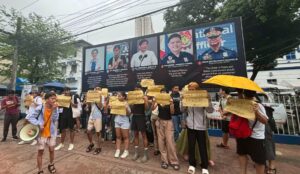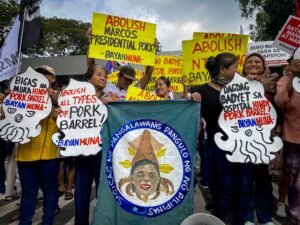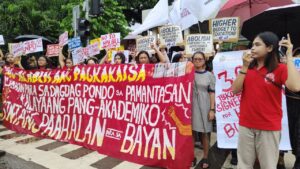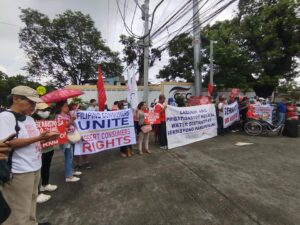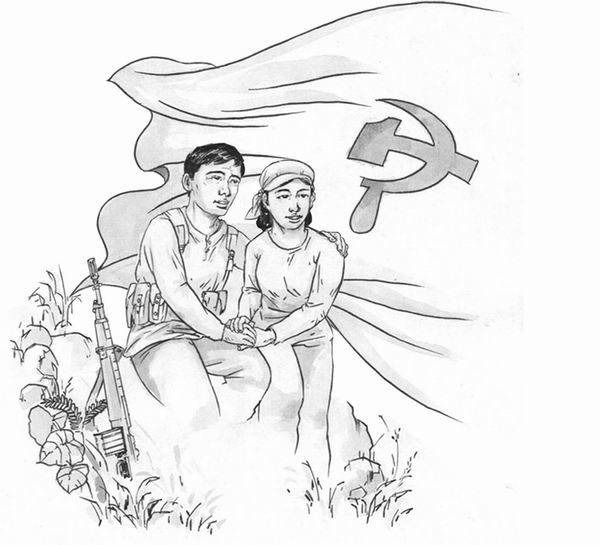
A love story: It started with a bracelet
For Valentine’s Day, Ang Bayan tells this story of two Red fighters who met, fell in love and got married under the guidance of the Party.
Translated from its Bisaya original, this is the story of Ka Safa and Ka Asyong.
____
“Love at first sight” is how Safa describes her first encounter with Asyong.
“I was in a youth conference back then, he was an instructor at Padepa (national-democratic school). His topic was on the national democratic revolution. He was clad in an all-black uniform and full battle gear while teaching. Wow, he’s so cool! I immediately had a crush on him , ” Safa recalled laughing. She was then a student activist for two years.
“I had my political reasons, too,” Safa quickly added. “He is good with comprehensive work, good in instruction, military work, highly-disciplined, not messy!”
When Safa decided to join the people’s army, she was deployed to Asyong’s unit where he served as the platoon’s medic. It was there that she fell in love with him.
“Not that handsome but up to my standards! Hahaha.” She noticed Asyong’s tidiness, that he had clean nails. “He knows how to embroider,” Safa shared. “I was even more impressed when I saw his skills in choreographing dances.”
On Asyong’s part, he first noticed Ka Safa’s openness and her interest in learning new things. “Very lively, down to earth,” he recalls thinking when he first met Safa. They had their interest in dance in common. Safa used to be a cheerleader and Asyong knew martial arts.
“She’s a very good listener, and is not arrogant,” Asyong said. “She might be city-bred but she’s not fussy. She eats whatever food we have in the forest. She easily fitted in with the comrades. She is quick to earn the trust of the masses. ”
Asyong also noticed Safa’s skills and initiative at all times. “Ka Safa has been a great help to our unit in the people’s army,” he said. “She had great recommendations for the development of activities inside the NPA.”
“On the other hand, she’s a slowpoke!” Asyong said fondly. “But she didn’t let her weaknesses stop her from participating in the armed struggle, and for that I fell in love with her.”
Asyong admits that at times, Safa finds it difficult to adjust especially when some situations change so fast. “But as she is always open to the advice of comrades, she has been able to overcome these situations.”
Their courtship began with agsam bracelets.
“Your bracelet design is so nice, Ka Asyong,” Safa remembered saying. “Can I have it?”
“I made it for you, actually, “Asyong answered with a smile.” I can even teach you so you can make one yourself.”
Safa laughed as she remembered thinking how handsome she found Asyong when he smiled. “His teeth are so even!” she thought then, “it’s like he once wore braces.” She thought of Asyong’s melting smile as his “most handsome” feature. Since then, Asyong has given her a lot of bracelets that have made her “kilig” (giddy).
“Too bad I lost most of them,” Safa said.
Although they knew the attraction was mutual, the two did nothing about it. In the people’s army, new recruits are not allowed to court, or to be courted, within a specific length of time so that they can focus on their duties. Long and clandestine conversations among “singles” are discouraged to avoid situations that create conditions for secret relationships.
“We did not talk without the presence of comrades. We went through the formal process,” Safa said. “I had plans of presenting a program (for a relationship) with Asyong to my collective.” In a “program” like this, a comrade formally expresses his/her/their intention to have a relationship with another comrade, spells out his/her/their basis, readiness and plans. If there are no complications, the unit of the “courtee” will send the program to the unit of the person who is being courted. “And then, he beat me to it!”
A year after Asyong sent his intentions, their respective units set up their meeting. “We talked and he told me he was going to court me,” Safa said. “Of course, I said yes right away.” But even though they were already in a relationship, they will be separated for the next two years. Asyong remained in his original unit to focus on military and political work while Safa was transferred to mass work.
While apart, they were very confident in one another. However, they also struggled with being away from each other in the beginning. There were times when they wanted to talk to each other on a daily basis or visit sooner even when the situation did not permit it. They overcame these situations.
“The comrades helped, as well as being in mass work,” said Ka Safa. “I was able to strengthen my revolutionary resolve, and to remold myself.”
During this time, Ka Safa came to appreciate the seriousness of being in a relationship inside the movement, as against having casual relationships in a bourgeois society.
“We met again after two years and assessed our feelings,” Safa said. They informed their collectives of their plans. Eventually, they were married under the Party flag.
Like many Party weddings, the couple met with their “godparents” — comrades who are or have been in long-lasting marriages–before the ceremony. They adviced the couple from the decades long experience of the Party in handling marriages.
“The advice of our comrades and the masses has been great,” said Asyong and Safa said. “Some said the marriage will strengthen us further. As we take on more responsibilities in the movement, we gain a partner in carrying out our tasks. ”
On the other hand, the comrades and masses also advised that marriage relations should not be tied to personal relationships alone and that political or comradely relations should always prevail.
“We should be honest with each other,” “Safa said.
“We promised each other that whatever problem we will face in our marriage should not get in the way of carrying out our tasks,”they said. “If we had problems, we will consult with our collectives.”
“Till death do us part” is a promise that is too real between two fighters who face life-and-death situations every day.
Ka Safa and Ka Asyong plan to have children one day.
“Two,” said Asyong. “With a 4-year gap between them so I wouldn’t be on successive maternity leaves,” added Safa. “And not immediately.”
They intend to give themselves time to get to know each other more and prepare for a family. Ka Safa knows the challenges that revolutionary women face, especially women fighters, when they have children. “It’s better to be prepared, to be firmly grounded on the proletarian way so that when personal problems arise, we will know how to handle them,” they said.
They trust the Party that will be able to take care of their future children. “Having others take care of our children does not mean that we are neglecting our responsibilities,” Ka Safa said. She understands that revolutionary mothers only expand this responsibility to the fight for national liberation.

